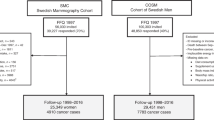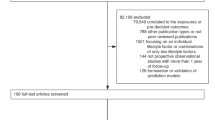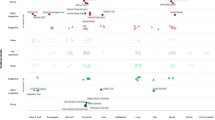Abstract
Background
The standardized scoring system assessing adherence to the 2018 World Cancer Research Fund (WCRF)/American Institute for Cancer Research (AICR) cancer prevention recommendations assigns equal weight for each recommendation, thereby giving higher weight to dietary factors collectively (5 points) than adiposity (1 point) and physical activity (1 point). An alternative score assigning equal weights to the adiposity, physical activity, alcohol, and other dietary (composite) recommendations may better predict cancer associations.
Methods
We examined associations between standardized and alternative scores with cancer risk in two US prospective cohorts. Multivariable-adjusted hazard ratios (HRs) and 95% confidence intervals (CIs) were calculated using Cox regression.
Results
During 28 years of follow-up, 16,342 incident cancer cases in women and 8729 cases in men occurred. Individuals in the highest versus lowest quintile of the standardized score had a reduced overall cancer risk (women: HR = 0.89, 95% CI: 0.85, 0.94; men: HR = 0.87, 95% CI: 0.81, 0.94). Results were slightly stronger for the alternative score (women: HR = 0.83, 95% CI: 0.79, 0.87; men: HR = 0.81, 95% CI: 0.75, 0.86). Similar patterns were observed for obesity-related, alcohol-related, smoking-related, and digestive system cancers.
Conclusions
Greater adherence to the WCRF/AICR cancer prevention recommendations was associated with lower cancer risk. A score assigning equal weights to the adiposity, physical activity, alcohol, and all remaining diet components yielded stronger associations than the standardized score.
This is a preview of subscription content, access via your institution
Access options
Subscribe to this journal
Receive 24 print issues and online access
$259.00 per year
only $10.79 per issue
Buy this article
- Purchase on Springer Link
- Instant access to full article PDF
Prices may be subject to local taxes which are calculated during checkout



Similar content being viewed by others
Data availability
The data and code that support the findings of this study are available from the authors upon reasonable request and with permission of the Harvard T.H. Chan School of Public Health and Channing Division of Network Medicine at Brigham and Women’s Hospital.
References
World Cancer Research Fund/American Institute for Cancer Research. Continuous Update Project Expert Report. Diet, nutrition, physical activity and prostate cancer. Available at dietandcancerreportorg 2018.
Solans M, Chan DSM, Mitrou P, Norat T, Romaguera D. A systematic review and meta-analysis of the 2007 WCRF/AICR score in relation to cancer-related health outcomes. Ann Oncol. 2020;31:352–68.
Shams-White MM, Brockton NT, Mitrou P, Romaguera D, Brown S, Bender A, et al. Operationalizing the 2018 World Cancer Research Fund/American Institute for Cancer Research (WCRF/AICR) cancer prevention recommendations: a standardized scoring system. Nutrients. 2019;11:1572.
Shams-White MM, Romaguera D, Mitrou P, Reedy J, Bender A, Brockton NT. Further guidance in implementing the Standardized 2018 World Cancer Research Fund/American Institute for Cancer Research (WCRF/AICR) Score. Cancer Epidemiol Biomark Prev. 2020;29:889–94.
Zhang FF, Cudhea F, Shan Z, Michaud DS, Imamura F, Eom H, et al. Preventable cancer burden associated with poor diet in the United States. JNCI Cancer Spectr. 2019;3:pkz034.
Rumgay H, Shield K, Charvat H, Ferrari P, Sornpaisarn B, Obot I, et al. Global burden of cancer in 2020 attributable to alcohol consumption: a population-based study. Lancet Oncol. 2021;22:1071–80.
Islami F, Goding Sauer A, Miller KD, Siegel RL, Fedewa SA, Jacobs EJ, et al. Proportion and number of cancer cases and deaths attributable to potentially modifiable risk factors in the United States. CA Cancer J Clin. 2018;68:31–54.
Islami F, Goding Sauer A, Gapstur SM, Jemal A. Proportion of cancer cases attributable to excess body weight by US State, 2011-2015. JAMA Oncol. 2019;5:384–92.
Papadimitriou N, Markozannes G, Kanellopoulou A, Critselis E, Alhardan S, Karafousia V, et al. An umbrella review of the evidence associating diet and cancer risk at 11 anatomical sites. Nat Commun. 2021;12:4579.
Minihan AK, Patel AV, Flanders WD, Sauer AG, Jemal A, Islami F. Proportion of cancer cases attributable to physical inactivity by US State, 2013-2016. Med Sci Sports Exerc. 2022;54:417–23.
Kaluza J, Harris HR, Håkansson N, Wolk A. Adherence to the WCRF/AICR 2018 recommendations for cancer prevention and risk of cancer: prospective cohort studies of men and women. Br J Cancer. 2020;122:1562–70.
Zhang ZQ, Li QJ, Hao FB, Wu YQ, Liu S, Zhong GC. Adherence to the 2018 World Cancer Research Fund/American Institute for Cancer Research cancer prevention recommendations and pancreatic cancer incidence and mortality: a prospective cohort study. Cancer Med. 2020;9:6843–53.
Barrubes L, Babio N, Hernandez-Alonso P, Toledo E, Ramirez Sabio JB, Estruch R, et al. Association between the 2018 WCRF/AICR and the low-risk lifestyle scores with colorectal cancer risk in the predimed study. J Clin Med. 2020;9:1215.
Barrios-Rodriguez R, Toledo E, Martinez-Gonzalez MA, Aguilera-Buenosvinos I, Romanos-Nanclares A, Jimenez-Moleon JJ. Adherence to the 2018 World Cancer Research Fund/American Institute for cancer research recommendations and breast cancer in the SUN project. Nutrients. 2020;12:2076.
Petimar J, Smith-Warner SA, Rosner B, Chan AT, Giovannucci EL, Tabung FK. Adherence to the World Cancer Research Fund/American Institute for Cancer Research 2018 recommendations for cancer prevention and risk of colorectal cancer. Cancer Epidemiol Biomark Prev. 2019;28:1469–79.
Korn AR, Reedy J, Brockton NT, Kahle LL, Mitrou P, Shams-White MM. The 2018 World Cancer Research Fund/American Institute for Cancer Research Score and Cancer Risk: a longitudinal analysis in the NIH-AARP diet and health study. Cancer Epidemiol Biomark Prev. 2022;31:1983–92.
Feskanich D, Rimm EB, Giovannucci EL, Colditz GA, Stampfer MJ, Litin LB, et al. Reproducibility and validity of food intake measurements from a semiquantitative food frequency questionnaire. J Am Dietetic Assoc. 1993;93:790–6.
Salvini S, Hunter DJ, Sampson L, Stampfer MJ, Colditz GA, Rosner B, et al. Food-based validation of a dietary questionnaire: the effects of week-to-week variation in food consumption. Int J Epidemiol. 1989;18:858–67.
Giovannucci E, Colditz G, Stampfer MJ, Rimm EB, Litin L, Sampson L, et al. The assessment of alcohol consumption by a simple self-administered questionnaire. Am J Epidemiol. 1991;133:810–7.
Rimm EB, Giovannucci EL, Stampfer MJ, Colditz GA, Litin LB, et al. Reproducibility and validity of an expanded self-administered semiquantitative food frequency questionnaire among male health professionals. Am J Epidemiol. 1992;135:1114–26.
Yuan C, Spiegelman D, Rimm EB, Rosner BA, Stampfer MJ, Barnett JB, et al. Validity of a dietary questionnaire assessed by comparison with multiple weighed dietary records or 24-hour recalls. Am J Epidemiol. 2017;185:570–84.
Rimm EB, Stampfer MJ, Colditz GA, Chute CG, Litin LB, Willett WC. Validity of self-reported waist and hip circumferences in men and women. Epidemiology. 1990;1:466–73.
Meyerhardt JA, Giovannucci EL, Holmes MD, Chan AT, Chan JA, Colditz GA, et al. Physical activity and survival after colorectal cancer diagnosis. J Clin Oncol. 2006;24:3527–34.
Hu FB, Li TY, Colditz GA, Willett WC, Manson JE. Television watching and other sedentary behaviors in relation to risk of obesity and type 2 diabetes mellitus in women. JAMA. 2003;289:1785–91.
Keum N, Cao Y, Oh H, Smith-Warner SA, Orav J, Wu K, et al. Sedentary behaviors and light-intensity activities in relation to colorectal cancer risk. Int J Cancer. 2016;138:2109–17.
Nguyen LH, Liu PH, Zheng X, Keum N, Zong X, Li X, et al. Chan AT, et al. Sedentary behaviors, TV viewing time, and risk of young-onset colorectal cancer. JNCI Cancer Spectr. 2018;2:pky073.
Mozaffarian D, Hao T, Rimm EB, Willett WC, Hu FB. Changes in diet and lifestyle and long-term weight gain in women and men. N Engl J Med. 2011;364:2392–404.
Wolf AM, Hunter DJ, Colditz GA, Manson JE, Stampfer MJ, Corsano KA, et al. Reproducibility and validity of a self-administered physical activity questionnaire. Int J Epidemiol. 1994;23:991–9.
Chasan-Taber S, Rimm EB, Stampfer MJ, Spiegelman D, Colditz GA, Giovannucci E, et al. Reproducibility and validity of a self-administered physical activity questionnaire for male health professionals. Epidemiology. 1996;7:81–6.
Al-Shaar L, Pernar CH, Chomistek AK, Rimm EB, Rood J, Stampfer MJ, et al. Reproducibility, validity, and relative validity of self-report methods for assessing physical activity in epidemiologic studies: findings from the women’s lifestyle validation study. Am J Epidemiol. 2022;191:696–710.
Pernar CH, Chomistek AK, Barnett JB, Ivey K, Al-Shaar L, Roberts SB, et al. Validity and relative validity of alternative methods to assess physical activity in epidemiologic studies: findings from the men’s lifestyle validation study. Am J Epidemiol. 2022;191:1307–22.
Khandpur N, Rossato S, Drouin-Chartier JP, Du M, Steele EM, Sampson L, et al. Categorising ultra-processed foods in large-scale cohort studies: evidence from the Nurses’ Health Studies, the Health Professionals Follow-up Study, and the Growing Up Today Study. J Nutr Sci. 2021;10:e77.
World Cancer Research Fund/American Institute for Cancer Research Continuous Update Project Expert Report: Body Fatness and Weight Gain. 2018. https://www.wcrf.org/dietandcancer/body-fatness-and-weight-gain/.
World Cancer Research Fund/American Institute for Cancer Research Continuous Update Project Expert Report: Alcoholic Drinks, 2018. https://www.wcrf.org/dietandcancer/alcoholic-drinks/.
IARC. Monographs on the evaluation of carcinogenic risks to humans - tobacco smoke and involuntary smoking (IARC, 2004),83.
Hurwitz LM, Agalliu I, Albanes D, Barry KH, Berndt SI, Cai Q, et al. Recommended definitions of aggressive prostate cancer for etiologic epidemiologic research. J Natl Cancer Inst. 2021;113:727–34.
Pernar CH, Ebot EM, Wilson KM, Mucci LA. The epidemiology of prostate cancer. Cold Spring Harb Perspect Med. 2018;8:a030361.
Hastert TA, Beresford SA, Sheppard L, White E. Adherence to the WCRF/AICR cancer prevention recommendations and cancer-specific mortality: results from the Vitamins and Lifestyle (VITAL) Study. Cancer Causes Control. 2014;25:541–52.
Cigarette smoking rates have fallen significantly for both youths and adults: American Lung Association analysis of CDC data. https://www.lung.org/research/trends-in-lung-disease/tobacco-trends-brief/overall-tobacco-trends. 2022.
IARC. Monographs on the evaluation of carcinogenic risks to humans, Alcohol Consumption and Ethyl Carbamate (IARC, 2010), 96.
Young SW, Candido E, Klein-Geltink J, Giesbrecht N. Preventing alcohol-related cancer: what if everyone drank within the guidelines? Can J Public Health. 2018;109:70–8.
Song R, Petimar J, Wang M, Tabung FK, Song M, Liu L, et al. Adherence to the World Cancer Research Fund/American Institute for Cancer Research cancer prevention recommendations and colorectal cancer survival. Cancer Epidemiol Biomark Prev. 2021;30:1816–25.
Tucker MA. Melanoma epidemiology. Hematol Oncol Clin North Am. 2009;23:383–95.
Chihara D, Nastoupil LJ, Williams JN, Lee P, Koff JL, Flowers CR. New insights into the epidemiology of non-Hodgkin lymphoma and implications for therapy. Expert Rev Anticancer Ther. 2015;15:531–44.
Wang P, Giovannucci EL. Are exposure-disease relationships assessed in cohorts of health professionals generalizable? A comparative analysis based on WCRF/AICR systematic literature reviews. Cancer Causes Control. 2023;34:39–45.
Acknowledgements
The authors would like to acknowledge the contribution to this study from central cancer registries supported through the Centers for Disease Control and Prevention’s National Program of Cancer Registries (NPCR) and/or the National Cancer Institute’s Surveillance, Epidemiology, and End Results (SEER) Program. Central registries may also be supported by state agencies, universities, and cancer centers. Participating central cancer registries include the following: Alabama, Alaska, Arizona, Arkansas, California, Delaware, Colorado, Connecticut, Florida, Georgia, Hawaii, Idaho, Indiana, Iowa, Kentucky, Louisiana, Maine, Maryland, Massachusetts, Michigan, Mississippi, Montana, Nebraska, Nevada, New Hampshire, New Jersey, New Mexico, New York, North Carolina, North Dakota, Ohio, Oklahoma, Oregon, Pennsylvania, Puerto Rico, Rhode Island, Seattle SEER Registry, South Carolina, Tennessee, Texas, Utah, Virginia, West Virginia, Wyoming.
Funding
The Nurses’ Health Study and Health Professionals Follow-up Study are supported by funding from the National Cancer Institute at the National Institute of Health under the award numbers UM1 CA186107, P01 CA87969, and U01 CA167552. Emily Riseberg is supported by funding from the National Research Service Award T32 DK 007703. The content is solely the responsibility of the authors and does not necessarily represent the official views of the National Institutes of Health.
Author information
Authors and Affiliations
Contributions
Conceptualization: E.L.G., S.A.S.-W., and J.P.; Formal analysis and investigation: R.S.; Original draft preparation: R.S.; Review and editing: E.R., J.P., M.W., L.A.M., K.W., X.Z., W.C.W., E.L.G., S.A.S.-W.; Funding acquisition: W.C.W., E.L.G., L.A.M.; Resources: E.L.G., S.A.S.-W.; Supervision: S.A.S.-W.
Corresponding author
Ethics declarations
Competing interests
The authors declare no competing interests.
Consent to participate
Informed consent was obtained from all individual participants included in the study.
Additional information
Publisher’s note Springer Nature remains neutral with regard to jurisdictional claims in published maps and institutional affiliations.
Supplementary information
Rights and permissions
Springer Nature or its licensor (e.g. a society or other partner) holds exclusive rights to this article under a publishing agreement with the author(s) or other rightsholder(s); author self-archiving of the accepted manuscript version of this article is solely governed by the terms of such publishing agreement and applicable law.
About this article
Cite this article
Song, R., Riseberg, E., Petimar, J. et al. Different operationalizations of the 2018 WCRF/AICR cancer prevention recommendations and risk of cancer. Br J Cancer 129, 982–992 (2023). https://doi.org/10.1038/s41416-023-02314-x
Received:
Revised:
Accepted:
Published:
Issue Date:
DOI: https://doi.org/10.1038/s41416-023-02314-x



